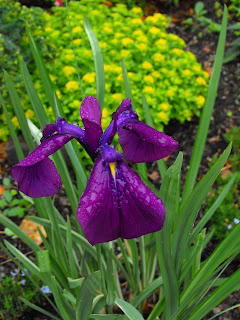Evanescent is not usually a word attached to the color purple, perhaps because its regal association gives it a gravitas that other colors may symbolically and metaphorically lack. Yet the varying hues of purple in my garden, much like variations of the color yellow, cast it in a particular richness and evoke variations of mood: the spring blooming Technicolor variegated Siberian iris speaks a vibrant language of expectation typical of the season, while the Purple Perilla, now in its late August (albeit misplaced) majesty, grounds the Maple tree bed (together with ajuga) in sharp contrast to the leavening effect of Hosta Undulata Albo-marginata.
Certain hues of purple in my garden—like the row of Liriope muscari that borders my front walkway and the anemone chrysanthemum situated at the walkway’s base transport me to a past I have forgotten, to a life I may or may not have lived, and to a set of memories I can only barely recall. I stall, if momentarily, at the base of the property, enraptured by these brilliant spikes of purple set against rich evergreen, gently arched foliage, the tunnel effect not lost on me, propelling me both backwards in thought and recollection and forward to the brick stairwell of welcome.
 Later in the autumn a single bloom chrysanthemum rewards with a mass of pale lavender blossoms on the opposite, east side of the sun garden, which proves a nice complement to Liriope. Their simultaneous bloom elevates and enlivens; the more somber, reflective evocations of Liriope alone dissipate, and together they beseech the visitor to cheer.
Later in the autumn a single bloom chrysanthemum rewards with a mass of pale lavender blossoms on the opposite, east side of the sun garden, which proves a nice complement to Liriope. Their simultaneous bloom elevates and enlivens; the more somber, reflective evocations of Liriope alone dissipate, and together they beseech the visitor to cheer.Such stimuli purple provides—from hope and expectation to evocation and recollection, from cheery welcome to arrested thought, from enchantment to gravitas—and for that reason I balk to think that the great English gardening guru Gertrude Jekyll thought purple to be a “difficult color” that should be “used sparingly” in the garden. Fortunately, that other great gardening guru, Vita Sackville-West, disregarded Jekyll’s admonitions and created the rich tapestry that is the Purple Border in the Top Courtyard of the Sissinghurst estate. Of course, Vita’s celebrated gift to gardening was the White Garden, but one should not overlook the herculean effects of the Purple Border and, more generally, the sumptuousness of generous uses of purple in the garden.
Be forewarned, however: purple is lifeless, dull, and sullen in the sun. At dawn and at dusk and on cloudy days, however, purple (especially in mass) conveys multiple moods, and evanesces even in its most magisterial of tones. Thus I would urge the gardener to use a preponderance of the softer, lighter shades in sunny areas, and darker purples as accents, and the reverse in shadier parts of the garden. Together, some of the lighter shades like Tall Purpletop Verbena and Sedum Autumn Joy, set against the silvery hues of Provence Lavender on one side and a blood red dahlia on the other, can positively transform a space by adding, unexpectedly, both levity and depth.
Perhaps of all the colors, purple encourages the gardener to be playful and to be serious, to fortify and soften garden spaces, to enrapture and subdue.In this sense, we must extend our thanks to Vita for serving as purple's advocate, for extricating it from the confines of shadow and accent. If red is the vanguard of the garden, then purple is the proletariat that carries out and forwards the work of the vanguard. And in this sense, it is pure dynamism. Even Simone agrees.








No comments:
Post a Comment